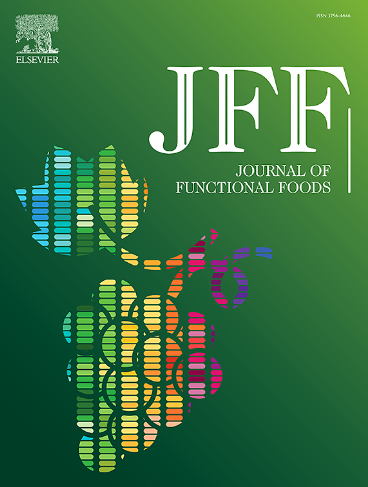番茄红素通过ncoa4诱导的铁下垂途径阻止环磷酰胺引起的肠道毒性
IF 3.8
2区 农林科学
Q2 FOOD SCIENCE & TECHNOLOGY
引用次数: 0
摘要
本研究探讨了番茄红素(LP)预防环磷酰胺(CYC)诱导肠道毒性的新机制。结果表明,与对照相比,磷酰胺芥(PM)处理显著降低了Caco-2细胞活力和SOD活性,提高了MDA含量,促进了Fe2+积累,上调了NCOA4。与PM处理相比,fe -1 + PM或siRNA-NCOA4 + PM显著增加Caco-2细胞GSH含量,降低ROS含量,抑制自噬,下调NCOA4和COX2,上调GPX4和FTH1。更重要的是,PM + 8 μM LP显著逆转了PM的这些作用。体内实验结果显示,与对照组相比,CYC小鼠肠道组织自噬明显增加,NCOA4和COX2蛋白上调,GPX4和FTH1蛋白下调。与CYC组相比,10 mg/kg LP + CYC显著扭转了上述现象。综上所述,LP通过阻断ncoa4介导的铁蛋白吞噬信号通路来抑制cyc诱导的铁凋亡。本文章由计算机程序翻译,如有差异,请以英文原文为准。

Lycopene prevents the intestinal toxicity caused by cyclophosphamide via NCOA4-induced ferroptosis pathway
This study evaluated the novel mechanism of lycopene (LP) preventing cyclophosphamide (CYC)-induced intestinal toxicity. The results of in vitro showed that compared with the control, phosphoramide mustard (PM) treatment significantly reduced Caco-2 cell viability and SOD activity, increased MDA content, promoted Fe2+ accumulation, and upregulated NCOA4. Compared with the PM treatment, Fer-1 + PM or siRNA-NCOA4 + PM significantly increased GSH content in Caco-2 cells, decreased ROS content, inhibited autophagy, downregulated NCOA4 and COX2, and upregulated GPX4 and FTH1. More importantly, PM + 8 μM LP significantly reversed these effects of PM. The results of in vivo showed that compared with the control, the autophagy in the intestinal tissues of CYC mice was significantly increased, and the NCOA4 and COX2 proteins were up-regulated, while the GPX4 and FTH1 were down-regulated. Compared with the CYC group, 10 mg/kg LP + CYC significantly reversed the above phenomenon. In conclusion, LP inhibited CYC-induced ferroptosis by blocking the NCOA4-mediated ferritinophagy signaling pathway.
求助全文
通过发布文献求助,成功后即可免费获取论文全文。
去求助
来源期刊

Journal of Functional Foods
FOOD SCIENCE & TECHNOLOGY-
CiteScore
9.60
自引率
1.80%
发文量
428
审稿时长
76 days
期刊介绍:
Journal of Functional Foods continues with the same aims and scope, editorial team, submission system and rigorous peer review. We give authors the possibility to publish their top-quality papers in a well-established leading journal in the food and nutrition fields. The Journal will keep its rigorous criteria to screen high impact research addressing relevant scientific topics and performed by sound methodologies.
The Journal of Functional Foods aims to bring together the results of fundamental and applied research into healthy foods and biologically active food ingredients.
The Journal is centered in the specific area at the boundaries among food technology, nutrition and health welcoming papers having a good interdisciplinary approach. The Journal will cover the fields of plant bioactives; dietary fibre, probiotics; functional lipids; bioactive peptides; vitamins, minerals and botanicals and other dietary supplements. Nutritional and technological aspects related to the development of functional foods and beverages are of core interest to the journal. Experimental works dealing with food digestion, bioavailability of food bioactives and on the mechanisms by which foods and their components are able to modulate physiological parameters connected with disease prevention are of particular interest as well as those dealing with personalized nutrition and nutritional needs in pathological subjects.
 求助内容:
求助内容: 应助结果提醒方式:
应助结果提醒方式:


